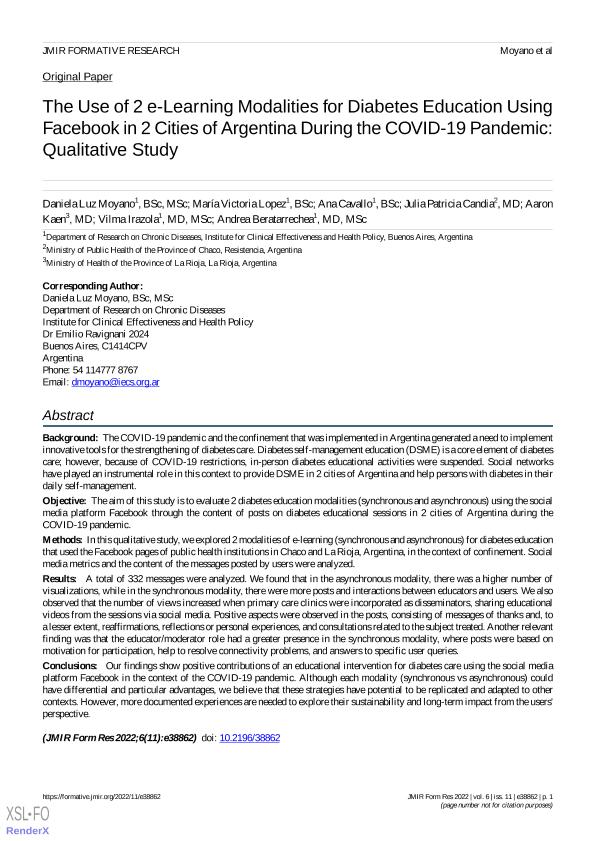Artículo
The Use of 2 e-Learning Modalities for Diabetes Education Using Facebook in 2 Cities of Argentina During the COVID-19 Pandemic: Qualitative Study
Moyano, Daniela Luz; López, Maria Victoria ; Cavallo, Ana; Candia, Julia Patricia; Kaen, Aaron Arnaldo; Irazola, Vilma
; Cavallo, Ana; Candia, Julia Patricia; Kaen, Aaron Arnaldo; Irazola, Vilma ; Beratarrechea, Andrea Gabriela
; Beratarrechea, Andrea Gabriela
 ; Cavallo, Ana; Candia, Julia Patricia; Kaen, Aaron Arnaldo; Irazola, Vilma
; Cavallo, Ana; Candia, Julia Patricia; Kaen, Aaron Arnaldo; Irazola, Vilma ; Beratarrechea, Andrea Gabriela
; Beratarrechea, Andrea Gabriela
Fecha de publicación:
11/2022
Editorial:
JMIR Publications Inc.
Revista:
JMIR Formative Research
e-ISSN:
2561-326X
Idioma:
Inglés
Tipo de recurso:
Artículo publicado
Clasificación temática:
Resumen
Background: The COVID-19 pandemic and the confinement that was implemented in Argentina generated a need to implement innovative tools for the strengthening of diabetes care. Diabetes self-management education (DSME) is a core element of diabetes care; however, because of COVID-19 restrictions, in-person diabetes educational activities were suspended. Social networks have played an instrumental role in this context to provide DSME in 2 cities of Argentina and help persons with diabetes in their daily self-management. Objective: The aim of this study is to evaluate 2 diabetes education modalities (synchronous and asynchronous) using the social media platform Facebook through the content of posts on diabetes educational sessions in 2 cities of Argentina during the COVID-19 pandemic. Methods: In this qualitative study, we explored 2 modalities of e-learning (synchronous and asynchronous) for diabetes education that used the Facebook pages of public health institutions in Chaco and La Rioja, Argentina, in the context of confinement. Social media metrics and the content of the messages posted by users were analyzed. Results: A total of 332 messages were analyzed. We found that in the asynchronous modality, there was a higher number of visualizations, while in the synchronous modality, there were more posts and interactions between educators and users. We also observed that the number of views increased when primary care clinics were incorporated as disseminators, sharing educational videos from the sessions via social media. Positive aspects were observed in the posts, consisting of messages of thanks and, to a lesser extent, reaffirmations, reflections or personal experiences, and consultations related to the subject treated. Another relevant finding was that the educator/moderator role had a greater presence in the synchronous modality, where posts were based on motivation for participation, help to resolve connectivity problems, and answers to specific user queries. Conclusions: Our findings show positive contributions of an educational intervention for diabetes care using the social media platform Facebook in the context of the COVID-19 pandemic. Although each modality (synchronous vs asynchronous) could have differential and particular advantages, we believe that these strategies have potential to be replicated and adapted to other contexts. However, more documented experiences are needed to explore their sustainability and long-term impact from the users' perspective.
Archivos asociados
Licencia
Identificadores
Colecciones
Articulos(CIESP)
Articulos de CENTRO DE INVESTIGACIONES EN EPIDEMIOLOGIA Y SALUD PUBLICA
Articulos de CENTRO DE INVESTIGACIONES EN EPIDEMIOLOGIA Y SALUD PUBLICA
Articulos(SEDE CENTRAL)
Articulos de SEDE CENTRAL
Articulos de SEDE CENTRAL
Citación
Moyano, Daniela Luz; López, Maria Victoria; Cavallo, Ana; Candia, Julia Patricia; Kaen, Aaron Arnaldo; et al.; The Use of 2 e-Learning Modalities for Diabetes Education Using Facebook in 2 Cities of Argentina During the COVID-19 Pandemic: Qualitative Study; JMIR Publications Inc.; JMIR Formative Research; 6; 11; 11-2022; 1-11
Compartir



